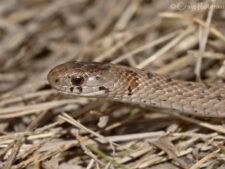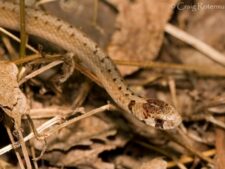
This snake grows to about 15 inches long (40 cm) with large eyes and round pupils. It has a grayish-brown color with darker brown blotches on the top of its head, as well as its body, decreasing in size towards its tail. There are several recognized subspecies of this snake. The subspecies thought to occur in eastern Nebraska is the Texas Brown Snake (Storeria dekayi texana).
This snake is not seen frequently because it spends most of its time underground. They are known to live up to 7 years, hibernating in winter, often in crowded dens along with other snake species. In March or April the males emerge from hibernation to follow female pheromone trails, which they sense with their forked tongues. Brown Snakes range from eastern Canada south to Florida, west to Texas and south through Mexico into Honduras.
Brown snakes feed largely on earthworms, snails and slugs but will also eat small salamanders, soft-bodied grubs and beetles. They have specialized teeth and jaws that allow them to pull snails out of their shells and eat them. They are predated by large frogs and toads, larger snakes, American crows, blue jays, hawks, shrews, weasels and domestic cats. When these snakes feel threatened they flatten their bodies to appear larger and place their bodies in an aggressive posture. They will also smear their attacker with a foul-smelling musk that they exude from their cloaca. Females give live birth to 12-20 young in late July to early August. No parental care is given to the young.
The content of NatureSearch is provided by dedicated volunteer Naturalists of Fontenelle Forest who strive to provide the most accurate information available. Contributors of the images retain their copyrights. The point of contact for this page is: Loren Padelford.










